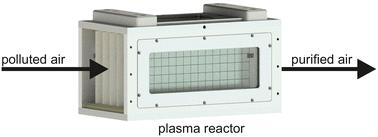当前位置:
X-MOL 学术
›
React. Chem. Eng.
›
论文详情
Our official English website, www.x-mol.net, welcomes your feedback! (Note: you will need to create a separate account there.)
A scalable twin surface dielectric barrier discharge system for pollution remediation at high gas flow rates
Reaction Chemistry & Engineering ( IF 3.9 ) Pub Date : 2022-08-01 , DOI: 10.1039/d2re00167e Alexander Böddecker 1 , Arisa Bodnar 1 , Lars Schücke 1 , Jonas Giesekus 1 , Katja Wenselau 1 , Ryan T. Nguyen-Smith 1 , Timothy Oppotsch 2 , Christian Oberste-Beulmann 2 , Martin Muhler 2 , Andrew R. Gibson 1, 3 , Peter Awakowicz 1
Reaction Chemistry & Engineering ( IF 3.9 ) Pub Date : 2022-08-01 , DOI: 10.1039/d2re00167e Alexander Böddecker 1 , Arisa Bodnar 1 , Lars Schücke 1 , Jonas Giesekus 1 , Katja Wenselau 1 , Ryan T. Nguyen-Smith 1 , Timothy Oppotsch 2 , Christian Oberste-Beulmann 2 , Martin Muhler 2 , Andrew R. Gibson 1, 3 , Peter Awakowicz 1
Affiliation

|
In this work, a modular, multi-electrode surface dielectric barrier discharge system for the decomposition of polluted air streams at high volumetric flows, necessary for industrial applications, is designed and constructed. The system is demonstrated for the decomposition of butoxyethanol and n-butane in ambient air flows of up to almost 500 slm (standard litres per minute) (≙ 30 m3 h−1) at concentrations between 50 ppm and 1000 ppm. With an energy density of (78.3 ± 3.6) J L−1 a maximum relative conversion of about 27% of butoxyethanol is achieved. n-Butane was used to enable comparison with previous studies. Here it could be demonstrated that the scaled-up source achieved higher conversion at lower energy densities in comparison to the original design used at lower volumetric flow rates. Additionally, the density of ozone, which is a toxic by-product of the overall process, was measured in the exhaust gas under different operating conditions and its degradation with activated carbon filters was studied. At an energy density of 79.6 J L−1 a maximum ozone molecule flow of (9.02 ± 0.19) × 1018 s−1 was measured which decreases with increasing energy density, because among other possible effects the rising temperature accelerates its decay. One of the activated carbon filters was able to reduce the concentration of toxic ozone by 100% under conditions where a preheated airstream is used.
中文翻译:

一种可扩展的双表面介质阻挡放电系统,用于在高气体流速下进行污染修复
在这项工作中,设计和构建了一个模块化的多电极表面介质阻挡放电系统,用于分解工业应用所必需的高体积流量的污染空气流。该系统被证明可分解环境空气流中的丁氧基乙醇和正丁烷,在 50 ppm 和 1000 ppm 之间的浓度下,环境空气流量高达几乎 500 slm(标准升/分钟)(≙ 30 m 3 h -1)。在(78.3 ± 3.6) JL -1的能量密度下,实现了约27%的丁氧基乙醇的最大相对转化率。n-丁烷用于与以前的研究进行比较。这里可以证明,与在较低体积流量下使用的原始设计相比,放大的源在较低的能量密度下实现了更高的转化率。此外,在不同操作条件下测量废气中臭氧的密度,臭氧是整个过程的有毒副产品,并研究了其在活性炭过滤器中的降解。在能量密度为 79.6 JL -1时,最大臭氧分子流量为 (9.02 ± 0.19) × 10 18 s -1被测量的随着能量密度的增加而降低,因为在其他可能的影响中,温度升高会加速其衰减。在使用预热气流的条件下,其中一种活性炭过滤器能够将有毒臭氧的浓度降低 100%。
更新日期:2022-08-05
中文翻译:

一种可扩展的双表面介质阻挡放电系统,用于在高气体流速下进行污染修复
在这项工作中,设计和构建了一个模块化的多电极表面介质阻挡放电系统,用于分解工业应用所必需的高体积流量的污染空气流。该系统被证明可分解环境空气流中的丁氧基乙醇和正丁烷,在 50 ppm 和 1000 ppm 之间的浓度下,环境空气流量高达几乎 500 slm(标准升/分钟)(≙ 30 m 3 h -1)。在(78.3 ± 3.6) JL -1的能量密度下,实现了约27%的丁氧基乙醇的最大相对转化率。n-丁烷用于与以前的研究进行比较。这里可以证明,与在较低体积流量下使用的原始设计相比,放大的源在较低的能量密度下实现了更高的转化率。此外,在不同操作条件下测量废气中臭氧的密度,臭氧是整个过程的有毒副产品,并研究了其在活性炭过滤器中的降解。在能量密度为 79.6 JL -1时,最大臭氧分子流量为 (9.02 ± 0.19) × 10 18 s -1被测量的随着能量密度的增加而降低,因为在其他可能的影响中,温度升高会加速其衰减。在使用预热气流的条件下,其中一种活性炭过滤器能够将有毒臭氧的浓度降低 100%。


























 京公网安备 11010802027423号
京公网安备 11010802027423号